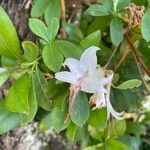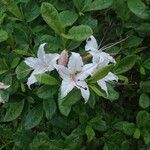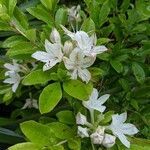Shrubs or trees, to 6 m, usually not rhizomatous. Stems: bark smooth to vertically furrowed, shredding; twigs glabrous or, very rarely, sparsely, widely scattered, unicellular and multicellular eglandular-hairy. Leaves decid-uous; petiole glabrous or multicellular eglandular-hairy; blade ovate to obovate, 3-8(-10.5) × 1.3-3.5 cm, thin, chartaceous, margins entire, plane, ciliate, eglandular-hairy, apex acute to obtuse, often mucronate, abaxial surface glabrous, (sometimes glaucous), adaxial surface glabrous, (lustrous). Floral bud scales usually glabrous abaxially, margins unicellular-ciliate. Inflorescences 3-7-flowered; bracts similar to bud scales. Pedicels 6-21 mm, glabrous or stipitate-glandular-hairy, sometimes also unicellular-hairy. Flowers opening after leaves, erect to horizontal, very fragrant; calyx lobes 0.8-6(-9) mm, surfaces and margins scattered, stipitate-glandular-and/or, sometimes, eglandular-hairy; corolla white or, sometimes, light pink (contrasting with dark pink to red style and filaments), without blotch on upper lobe, funnelform, 30-55 mm, stipitate-glandular-hairy (hairs continuing in lines up lobes), otherwise glabrous or sparsely unicellular-hairy on outer surface, petals connate, lobes 10-24 mm, tube ± gradually expanded into lobes, 20-37 mm (equaling or much longer than lobes); stamens 5, much exserted, ± unequal, 44-82 mm. Capsules borne on erect pedicels, 8-17 × 4.5-8 mm, ± densely multicellular stipitate-glandular-hairy, sometimes also sparsely unicellular-hairy. Seeds with-out distinct tails; testa not dorsiventrally flattened, usually ± loose. 2n = 26.
More
Tall shrub or small tree to 6 m, not colonial, with glabrous twigs and bud-scales; lvs oblanceolate or rarely obovate, 5–8 cm, obscurely hairy on the midvein above and beneath, otherwise glabrous; fls fragrant; pedicels and cor-tube stipitate-glandular, not otherwise hairy; sep 1.5–3(–5) mm; cor white, occasionally flushed with red, often with a yellow blotch on the upper lobe, 4–5 cm wide, the tube 2.5–3 cm; exserted part of filaments somewhat longer than the tube; stamens and style red, the style ca 1 cm longer than the stamens. Upland woods, especially in the mts.; Pa. to Ky., s. to Ga. and Ala. June, July. (Azalea a.)




